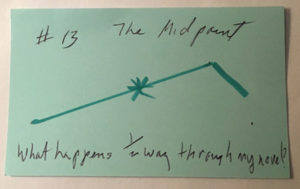Novel Basics: Card # 12
The Climax Card

The Climax Scene Card asks the question,
“What’s the high point of my novel’s plot?”
Back when I taught Creative Writing at one of America’s top community colleges, often as I introduced the topic of the moment of the highest intensity of your plot, the part of your plot that the entire book has led up to, some young male would snicker as he leaned over to the young female he wanted to impress and make some remark about climaxes that he figured that I wouldn’t understand because as a professor I was just too naïve about all such subjects.
“Yeah, yeah, yeah, that’s what it’s usually called, kiddo. Get over it,” I didn’t have time to say.
At any rate, the climax scene, aka the crisis and the catastrophe, can and often does show the do-or-die moment. It’s the highest point on the inverted check mark. Perhaps it involves the final confrontation between the protagonist and antagonist. Christopher Vogler in The Writer’s Journey, his excellent book on mythic structure for fiction and scriptwriters, calls this scene “the ultimate ordeal.” In a coming-of-age novel or a novel of ideas, the strongest, most powerful and intense scene may be when the protagonist has an epiphany about himself or life itself.
Traditionally, the climactic scene brings about a change in the protagonist’s fate, for better–he gets the girl and lives happily ever after with her–or for worse–he dies.
It’s the point in the novel when the protagonist finally resolves the problem of the book or dies trying, when Captain Ahab, for instance, finally confronts the whale in Moby Dick and dies.
In a western, it might be the shoot-out between the sheriff and the leader of the robber gang. In a traditional British murder mystery, it’s the scene in the library when the detective reveals the identity of the killer. In a romance, the lovers resolve their differences at last. In a coming-of-age novel, it might be the scene in which the protagonist finally discovers the truth about her father or his mother. In Stephen King’s psychological horror thriller Misery, Paul Sheldon finally vanquishes his number one fan, the cruel nurse Annie Wilkes.
Sometimes the climax might be a fairly intimate scene, with just the villain and the hero duking it out in the dark. Many mysteries have this sort of pivotal scene, but some novels have much larger climactic scenes with whole armies facing each other on the battlefield. I’ve grown to admire the climactic scenes in the cozy mysteries of Nancy Martin and the romantic adventures of Janet Evanovich for the way both authors bring together every major character in a dramatic, yet comic scene that resolves the mystery at last.
An important tip: avoid letting another character rescue the protagonist at the climax, a fairly common mistake for beginners. In a good, solid plot, the protagonist’s lover can’t come riding up on a white horse, fell the villain, and cut the ropes that tie the damsel to the railroad track. If the damsel is the protagonist, she has to do all of that herself and have the villain’s neck under her dainty foot when the lover rides up on his white horse, slightly too late.
So at least tentatively figure out which of the obstacles the hero confronts is the most intense, the do-or-die moment for your book to describe briefly on your Climax Scene Card. Now let’s move on to another major scene of your novel.
Novel Basics: Card # 13
The Midpoint Scene

The Midpoint Scene Card asks the question,
“What happens halfway through my novel?”
About midway through your novel, you will need a scene in which the plot takes a surprising turn of events or shifts in a new direction. The midpoint scene is very important structurally for your novel. For one thing, if you have a strong midpoint scene, your novel will not sag in the middle, a flaw I’ve heard at least one successfully published novelist complain about.
The midpoint scene is sometimes called the rug pulling because things seem to have been going well for the protagonist, but now something happens that changes everything for him, so he might have to start over again or almost. (The middle point of a W is a really good way of representing this part of a novel.)
For example, after a great struggle involving many challenges, the lone mountain climber grabs a loose rock and falls into a crevasse and breaks her leg. Oh gosh, the reader says. Will she get out of there? And how? Will she make it to the top? (FYI: she can’t get rescued here either.)
In her Adam Dalgliesh novel Original Sin, P. D. James waits until midpoint for the murder to occur after we’ve gotten to know all the characters including the detectives, the suspects and the victim.
In a romance, the guy and the gal get to know each other or at least try to in the first part of Act 2, but about halfway through Act 2 they have a misunderstanding or a falling out. For example, around the middle of Pride and Prejudice, Mr. Darcy proposes to Elizabeth Bennet for all the wrong reasons and quite rightly she refuses him.
The midpoint doesn’t necessarily have to be negative. Perhaps in the first half of the book, your heroine has overcome some of her initial obstacles to achieving her goal of getting the guy. And now, strengthened by surmounting earlier obstacles, she’s gained the ability to confront the more challenging obstacles to come in the second half of the novel.
In her excellent book How to Write Killer Fiction, Carolyn Wheat says that in the first half of Act 2 of a mystery we have the first detection. In this section typically the detective is on the false track or the bumbling police detective gets it all wrong. But at midpoint something happens that leads to the second detection and the correct solution. The detective’s prime suspect turns up dead, for instance. Or Miss Marple takes over the investigation.
In The Hunger Games, Katniss Everdeen receives her first gift from her sponsor on page 188 of the 374-page novel.
Next time, we’ll consider two last major scenes you need to figure out as you’re brainstorming your novel.
